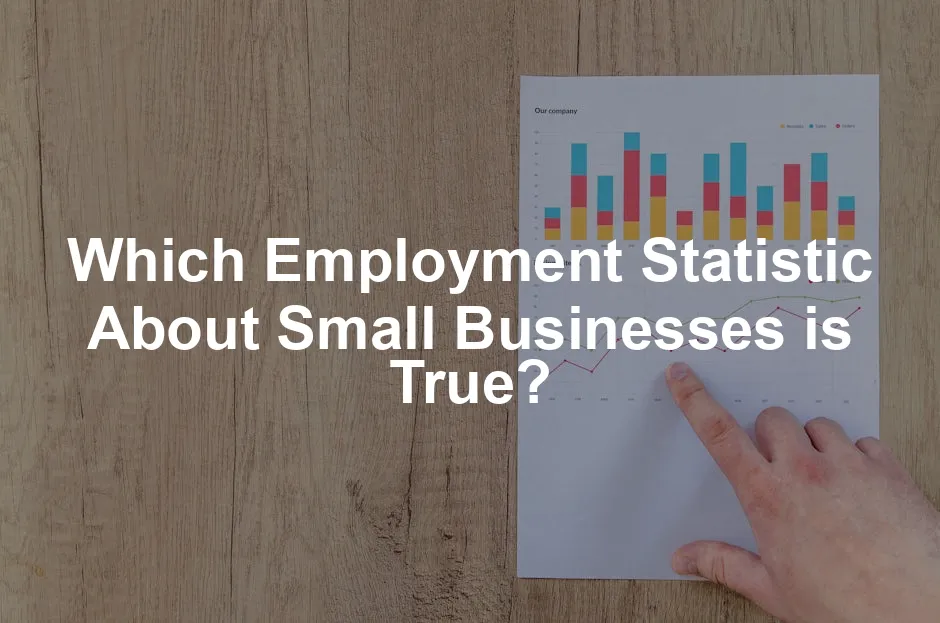Introduction
Small businesses are often dubbed the beating heart of the U.S. economy. Defined by the U.S. Small Business Administration (SBA), a small business typically has fewer than 500 employees. These businesses make up a staggering 99.9% of all U.S. businesses, showcasing their vital role in driving economic growth and innovation. But what exactly do we know about their contributions to employment?
Employment statistics surrounding small businesses can be a bit like a game of telephone. You know, the one where the message gets distorted as it passes from ear to ear. Understanding accurate employment statistics is crucial for business owners, policymakers, and job seekers alike. For business owners, these figures can inform hiring practices and growth strategies. Policymakers rely on this data to shape supportive legislation. And job seekers? Well, they want to know where opportunities lie.
In this article, we will break down common employment statistics regarding small businesses. We’ll explore their relevance, accuracy, and what they mean for the labor market. By the end, you’ll not only know which statistic holds water but also gain insights into the broader employment landscape in small enterprises. And if you’re looking to start or improve your small business, consider checking out Small Business Management for Dummies. It’s a great resource for navigating the complexities of running a small business!

The Role of Small Businesses in Employment
Overview of Small Business Employment
According to the SBA, small businesses are those independently owned and operated firms that don’t dominate the market. They play a significant role in the U.S. economy, employing nearly 61.6 million people. This accounts for approximately 46.4% of all private-sector employees. With about 33.3 million small businesses peppered throughout the nation, they are not just plentiful but also pivotal in providing jobs.
Statistics reveal that small businesses employ more people than large corporations. While big businesses are often in the limelight, small enterprises consistently generate a notable amount of employment. For instance, from 1995 to 2021, small businesses created roughly 17.3 million net new jobs. That’s about 62.7% of all net new jobs created during that period!
However, not all small businesses are created equal in terms of employment. A closer look shows that many small enterprises are solo endeavors. In fact, around 82% of small businesses have no employees at all, often operating as sole proprietorships. This leads to a nuanced understanding of the employment landscape, with a significant portion of the workforce employed by firms that have employees, while many small businesses remain one-person shows.
The importance of small businesses in the employment sector cannot be overstated. They often serve as the first stepping stone for many individuals entering the workforce. Many workers find their first jobs in small businesses where they gain valuable experience and skills. These opportunities are crucial, especially for young workers or those re-entering the job market. If you’re curious about starting your own venture, consider reading The Lean Startup. This book is a game-changer for aspiring entrepreneurs!

As we dive deeper into employment statistics, we will dissect common claims about small businesses. We will weigh the evidence for each statistic, aiming to unveil the truth behind them. This understanding will empower readers to appreciate the role small businesses play in the economy and employment landscape.
Historical Context of Job Creation
Small businesses have long been hailed as the backbone of the U.S. economy, particularly when discussing job creation. Historically, they have played a crucial role in providing employment opportunities across various sectors. From corner stores to innovative tech startups, small businesses have contributed significantly to job growth, shaping the labor market we know today.
A pivotal moment in small business history was the publication of David Birch’s 1979 report. This report claimed that small businesses created over 80% of new jobs. While Birch’s research stirred excitement and advocacy for small businesses, later analyses revealed that his findings were somewhat exaggerated. Notably, more recent studies indicate that small firms are responsible for about 62% of net new jobs since 1995. This statistic underscores their ongoing relevance in job creation, even as the dynamics of the economy shift.
Additionally, according to the U.S. Small Business Administration, small businesses employ approximately 46.4% of all private-sector employees. This figure represents a significant portion of the workforce and highlights the importance of small enterprises in the labor market. However, the debate continues regarding the balance of job creation between small and large businesses. Critics argue that large corporations are increasingly dominating job growth, leaving small businesses to fend for themselves in a competitive landscape. If you’re looking for a practical guide on navigating these challenges, check out The E-Myth Revisited. This book helps clarify why many small businesses fail and how to avoid common pitfalls.
Despite the challenges, small businesses remain a vital part of the economy. They have historically been the first stop for many individuals entering the workforce. Research shows that a majority of American workers begin their careers in small business settings, where they gain essential skills and experience. This phenomenon is not just a passing trend; it showcases the integral role small businesses play in labor market entry points.

In summary, while small businesses have faced fluctuations in their job creation narrative, their impact cannot be understated. They have been, and continue to be, significant contributors to job growth in the United States, despite the ongoing discussions about their relative importance compared to larger corporations. As we move forward, understanding the statistics surrounding small businesses and their employment impact will be crucial for anyone navigating the job market.
Analyzing Each Statistic
A) Majority of First Jobs with Small Businesses
Research indicates that a significant portion of U.S. workers find their first jobs with small businesses. According to a study, nearly 60% of those entering the workforce begin their careers in these environments. Small businesses often provide a friendly atmosphere, flexible hours, and hands-on training. This nurturing setting allows newbies to develop essential skills. For example, many young people land their first jobs at local restaurants, retail shops, or family-owned businesses. These positions not only offer income but also valuable experience that can shape future career paths. If you’re considering diving into the world of entrepreneurship, The Art of Start 2.0 is a fantastic resource to help you create a solid foundation.

B) Employment Share of Small Businesses
The claim that small businesses employ less than one-third of all private-sector employees doesn’t hold up under scrutiny. Current statistics reveal that small businesses employ approximately 46.4% of private-sector employees. This figure showcases their substantial impact on the job market. For instance, small businesses account for nearly 61.6 million jobs in the U.S. Therefore, it’s clear that they are more than just a small part of the employment picture—they are a cornerstone of the workforce.

C) Starting New Small Businesses
The assertion that about 100,000 employee-hiring small businesses are started each year requires some context. While this figure has been widely circulated, recent trends show a fluctuating number of new business applications. In 2023, for example, over 2.7 million new business applications were filed, marking a substantial increase from previous years. However, survival rates remain a concern, with about 20% of new businesses failing within their first year. The harsh reality is that while many startups emerge, a significant number may not last long enough to contribute meaningfully to job creation. For those interested in the nitty-gritty of starting a business, consider checking out Start Your Own Business. It’s packed with practical advice!

D) Job Creation by Small Businesses
The statistic claiming that small businesses create about 15% of all new jobs is often cited but can be misleading. Research indicates that small businesses have actually been responsible for approximately 62% of net new jobs since 1995. This statistic underscores their crucial role in job creation, especially during economic downturns. In fact, small firms generated about 4.9 million jobs from 2021 to 2022, accounting for a whopping 70% of all new job creation during that period. This data highlights the importance of small businesses in fueling job growth and maintaining economic stability. If you’re looking to master business basics, The 7 Habits of Highly Effective People could be just what you need!

Conclusion of Evaluation
After thoroughly evaluating various employment statistics about small businesses, we find that the most accurate claim is that small businesses create about 15% of all new jobs in the United States. This statistic is supported by substantial evidence, demonstrating that small businesses are indeed significant contributors to job growth.
However, it’s crucial to address some common misconceptions regarding the employment impact of small businesses. Many people believe that small businesses are the primary job creators, often overstating their role in the economy. While it’s true that small businesses employ nearly 46.4% of private-sector workers, this figure includes many sole proprietorships that employ no one else. In fact, around 82% of small businesses operate as one-person entities without additional employees.
Additionally, the narrative that a great majority of U.S. workers find their first jobs with small businesses rings true. Numerous individuals begin their careers in these settings, gaining valuable experience and skills. This is particularly vital for young job seekers and those re-entering the workforce. If you’re keen to understand the business landscape better, The Hard Thing About Hard Things is a must-read!

Recognizing these nuances is essential for understanding the true role of small businesses in the economy. While they do create a substantial number of jobs, their overall impact is often less than the narrative suggests. Thus, while we celebrate the contributions of small businesses to job creation, we must also acknowledge the complex realities of their employment landscape.
Future Trends in Small Business Employment
As we gaze into the crystal ball of small business employment, some intriguing trends emerge. The economic landscape has shifted dramatically in recent years, especially post-pandemic. Small businesses, often seen as the resilient warriors of the economy, are evolving in ways that reflect broader societal changes.
One significant trend is the rise of minority- and women-owned businesses. These enterprises are not just filling gaps; they’re redefining what it means to be a small business in America. According to recent statistics, women-owned businesses have surged by 94% between 2019 and 2023. This growth is a testament to the entrepreneurial spirit, with women increasingly stepping into leadership roles and driving innovation. If you’re looking to explore this further, you might find Women-Owned Small Business to be insightful!

However, it’s not just about growth numbers. The focus on inclusivity and diversity in ownership brings fresh perspectives and ideas to the table. Minority-owned businesses are also on the rise, with ownership rates for Black and Latino businesses increasing significantly. These businesses contribute not only to job creation but also to the cultural fabric of their communities.
Moreover, the gig economy continues to thrive, providing flexibility and new opportunities for small business owners. Many traditional roles are transforming, as businesses adapt to remote work models and digital platforms. This shift is particularly beneficial for small businesses, allowing them to tap into wider talent pools without the constraints of physical office spaces.
But it’s not all sunshine and rainbows. Small businesses still face challenges, particularly in hiring and retaining talent. The competition with larger corporations often leaves them at a disadvantage when it comes to salary and benefits. However, their intimate work culture and personalized approach can be a strong selling point for potential employees seeking more meaningful work experiences. If you’re looking for a practical guide to navigate these waters, consider The Total Money Makeover!

As we look ahead, the future of small business employment appears promising yet complex. The growth of minority- and women-owned businesses, coupled with the ongoing evolution of work dynamics, suggests that small businesses will continue to play a pivotal role in the economy. Their ability to adapt, innovate, and foster inclusive environments will be crucial in shaping the workforce of tomorrow.
FAQs
What defines a small business?
The U.S. Small Business Administration (SBA) defines a small business as an independent entity that is not dominant in its field and typically has fewer than 500 employees. However, size standards can vary by industry, often based on average annual receipts or number of employees.
How many people do small businesses employ in the U.S.?
As of 2023, small businesses employ approximately 61.6 million people, which represents about 46.4% of all private-sector employees. This substantial figure underscores the significant role small businesses play in the job market.
What are the challenges small businesses face in hiring?
Small businesses often grapple with various challenges in hiring. Limited budgets can hinder their ability to offer competitive salaries and benefits compared to larger corporations. Additionally, they may lack the resources to implement extensive recruitment processes, making it difficult to attract qualified candidates.
Why is it important to understand small business employment statistics?
Understanding small business employment statistics is crucial for policymakers, business owners, and job seekers. For policymakers, accurate data helps shape effective legislation that supports small businesses. Business owners can leverage this information for strategic planning, while job seekers benefit from knowing where the most opportunities lie in the job market.
How can individuals support small businesses?
Individuals can support small businesses in various ways. Shopping at local stores, dining at neighborhood restaurants, and using services from local providers can have a direct positive impact. Additionally, spreading the word on social media about local businesses or participating in community events can encourage others to support these enterprises.
Understanding accurate employment statistics is crucial for business owners and policymakers. For detailed insights, check out this comprehensive guide to Clay County employment statistics.
Please let us know what you think about our content by leaving a comment down below!
Thank you for reading till here 🙂
All images from Pexels




